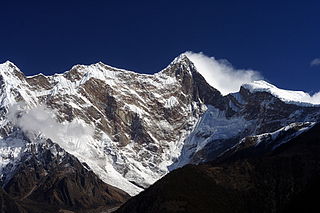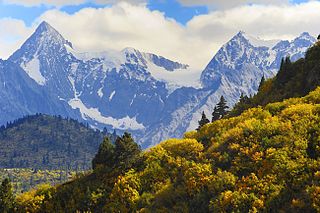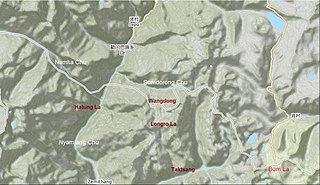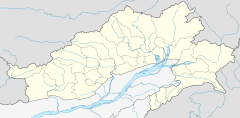
Tawang district is the smallest of the 26 administrative districts of Arunachal Pradesh state in northeastern India. With a population of 49,977, it is the eighth least populous district in the country.

Tawang is a town and administrative headquarter of Tawang district in the Indian state of Arunachal Pradesh. It lies on NH-13 section of Trans-Arunachal Highway. The town was once the headquarter of the Tawang Tract, which is now divided into the Tawang district and the West Kameng district. Tawang continues as the headquarters of the former. Tawang is the number one tourist destination of Arunachal Pradesh.

The Friendship Highway is an 800-kilometre (500 mi) scenic route connecting the capital of Tibet, Lhasa, with the Chinese/Nepalese border at the Sino-Nepal Friendship Bridge between Zhangmu and Kodari. It includes the westernmost part of China National Highway 318 (Shanghai-Zhangmu) and crosses three passes over 5,000 m (16,400 ft) before dropping to 1,750 m (5,700 ft) at the border.

Lake Pelku, Pelkhu, or Paiku is a lake at 4,591 meters (15,062 ft) elevation on the Tibetan Plateau in Shigatse Prefecture. It is 18 kilometers (11 mi) south of the Yarlung Tsangpo (Brahmaputra) River, bordering Saga County, Gyirong County, and Nyalam County.

Namcha Barwa or Namchabarwa is a mountain peak lying in Tibet in the region of Pemako. The traditional definition of the Himalaya extending from the Indus River to the Brahmaputra would make it the eastern anchor of the entire mountain chain, and it is the highest peak of its own section as well as Earth's easternmost peak over 7,600 metres (24,900 ft). It lies in the Nyingchi Prefecture of Tibet. It is the highest peak in the 180 km long Namcha Barwa Himal range, which is considered the easternmost syntaxis/section of the Himalaya in southeastern Tibet and northeastern India where the Himalaya are said to end, although high ranges actually continue another 300 km to the east.

Pasho County or Baxoi County is a county under the administration of Chamdo Prefecture in the Tibet Autonomous Region, China. The county seat is at Pema, which is also called the "Pasho Town". The county population is 35,273 (1999). It contains the Pomda Monastery and Rakwa Tso lake.

Pome County or Bomê County is a county of Nyingchi Prefecture in the south-east of the Tibet Autonomous Region. Historically known as Powo or Poyul, it was the seat of a quasi-independent kingdom until the early 20th century when troops of the Dalai Lama's Lhasa government integrated it into the central Tibetan realm. The population was 25,897 in 2004.

In 1986–87, a military standoff took place between India and China in the Sumdorong Chu Valley bordering the Tawang district, Arunachal Pradesh and Cona County, Tibet. It was initiated by China moving a company of troops to Wangdung, a pasture to the south of Sumdorong Chu that India believed to be its territory. The Indian troops stood their ground on the neighbouring Longro La ridge and both the sides moved a large number of troops to the border. The crisis was diffused after the visit of Indian External Affairs minister to Beijing in May 1987. The standoff gave rise to fears of escalation. Subsequently, India and China formulated agreements for managing future border tensions.

Tsona City, formerly Tsona County, is a county-level city in Shannan Prefecture in the southeastern part of the Tibet region of China. Tsona means "The face of the [Nara Yumco] lake" in Tibetan. It lies immediately to the north of the McMahon Line agreed as the mutual border between British India and Tibet in 1914. China has not accepted the 1914 border delineation, but treats it as the Line of Actual Control (LAC). Tsona also borders Bhutan on its southwest.

The Nyang River is a major river in south-west Tibet and the second largest tributary of the Yarlung Tsangpo River by discharge.

The Yarlung Tsangpo, also called Yarlung Zangbo and Yalu Zangbu River is located in the Tibet Autonomous Region, China. It is the longest river of Tibet and the fifth longest in China. The upper section is also called Dangque Zangbu meaning "Horse River."

The Subansiri is a trans-Himalayan river and a tributary of the Brahmaputra River that flows through Tibet's Lhuntse County in the Shannan Prefecture in Southwestern China, and the Indian states of Arunachal Pradesh and Assam. The Subansiri is approximately 518 kilometres (322 mi) long, with a drainage basin 32,640 square kilometres (12,600 sq mi). It is the largest tributary of the Brahmaputra contributing 7.92% of the Brahmaputra's total flow.
Milakatong La or Menlakathong La is a historic mountain pass along the trade route between Tawang in India's Arunachal Pradesh and Tsona Dzong in Tibet's Shannan province via the valley of Tsona Chu.
Sumdorong Chu is a tributary of the Nyamjang Chu river that flows along the disputed Sino-Indian border between the Tsona County of Tibet and the Tawang district of Arunachal Pradesh. It originates in the Tokpo Shiri Glacier, about 7–10 kilometres east of Nyamjang Chu, and flows down to the river. Its junction with Nyamjang Chu is about two kilometers to the north of that of Namka Chu, another contested river valley.

Namka Chu or Kejielang River is a tributary of Nyamjang Chu that flows along the disputed border between India and China. The Indian side of the border is the Tawang district in Arunachal Pradesh. The Tibetan side of the border is in Tsona Dzong, Shannan province of Tibet. Namka Chu originates near the trijunction of Tibet, Bhutan and India and flows east for 26 km before joining Nyamjang Chu. It is about 200 kilometers away from the Misamari railhead and 60 kilometers from the Tawang road head. The Namka Chu valley was the scene of some of the most fierce fighting during the 1962 Sino-Indian war.
Dhola Post was a border post set up by the Indian Army in June 1962, at a location called Che Dong, in the Namka Chu river valley area disputed by China and India. The area is now generally accepted to be north of the McMahon Line as drawn on the treaty map of 1914, but it was to the south of the Thagla Ridge, where India held the McMahon Line to lie. On 20 September 1962, amidst various border tensions, the post was attacked by Chinese forces from the Thagla Ridge, and sporadic fighting continued till 20 October when an all-out attack was launched by China leading to the Sino-Indian War. Facing an overwhelming force, the Indian Army evacuated the Dhola Post as well as the entire area of Tawang, retreating to Sela and Bomdila. After the war, the post was left unoccupied until the 1986 Sumdorong Chu standoff, after which the area was again strengthened by the Indian Army.

Tawang Chu is the main river of the Tawang district in Arunachal Pradesh, India. The entire district may be regarded as the basin of the Tawang Chu river. In addition, two south-flowing rivers from Tibet, viz., the Tsona Chu and Nyamjang Chu, join the river within the district. The combined river flows west into Bhutan, where it progresses to the Manas River and flows into the Assam state of India.

Zemithang or Pangchen, is a village and the headquarters of an eponymous circle in the Tawang district of Indian state of Arunachal Pradesh. It is on the bank of the Nyamjang Chu river, which originates in Tibet and enters India from the north near the locality called Khinzemane.
Chumi Gyatse Falls, called Domtsang and Dongzhang waterfalls in Tibetan and Chinese languages respectively, are a collection of waterfalls in the Tawang district in Arunachal Pradesh, India, close to the border with the Tibet region of China. According to the local Buddhist tradition, the 108 holly water falls which originate from in-between the mountains symbolise the blessings of Guru Padmasambhava. The Chumi Gyatse Falls are close to the Line of Actual Control, the de facto border between China and India, just 250 metres away according to one account.
Tulung La (Tibetan: ཐུ་ལུང་ལ་, Wylie: thu lung la) is a border pass between the Tsona County in the Tibet region of China and India's Tawang district in Arunachal Pradesh. It is in the eastern part of the two districts, close to the Gori Chen cluster of mountains, on a watershed between the Tsona Chu river in Tibet and the Tawang Chu in the Tawang district. The watershed ridge forms the border between Tibet and India as per the McMahon Line. Tulung La provided an invasion route to China during the 1962 Sino-Indian War. It is also the scene of occasional clashes between the two sides.
















